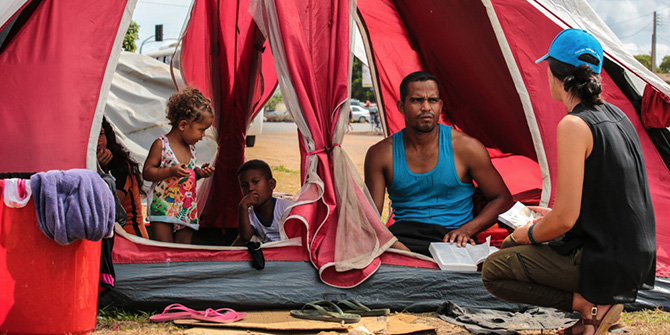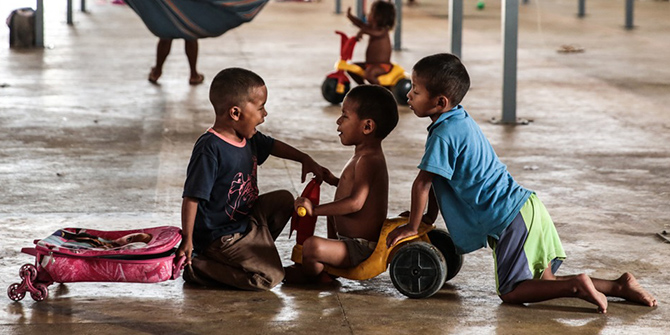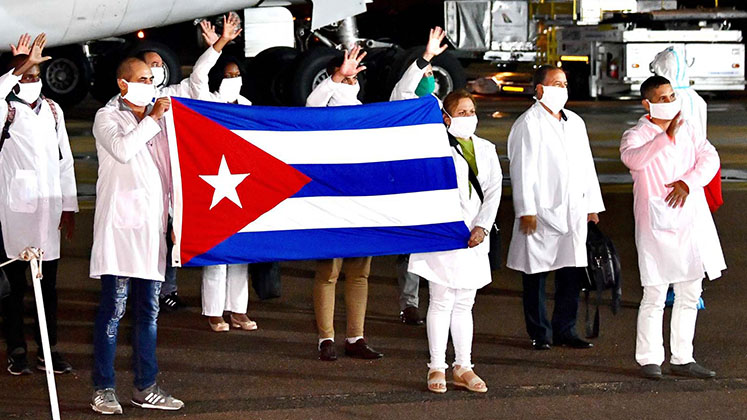
 Though Venezuelan emigration has passed through phases like those of the European migration crisis, issues of foreign policy have seen Latin America respond quite differently to large-scale migration, write Nicolas Parent and Luisa Feline Freier (Universidad del Pacífico, Peru).
Though Venezuelan emigration has passed through phases like those of the European migration crisis, issues of foreign policy have seen Latin America respond quite differently to large-scale migration, write Nicolas Parent and Luisa Feline Freier (Universidad del Pacífico, Peru).
Though media and politicians in the Global North have condemned Venezuelan President Nicolás Maduro and denounced the political conditions which have wrought socioeconomic horrors on the country since 2014, they have not been so swift to tune into regional responses to the resulting migratory outflows.

With respect to social science research, there are very few migration scholars who have written on topic. Reflecting the well-established divide between the Global North and South in the production of knowledge, migration scholars in the West typically focus on international South-North migration.
As public and political awareness affects not only the global conversation on forced migration but also policy responses, there is a need to place the Venezuelan exodus – the largest forced displacement of people in the history of Latin America – in the conversation on global migration management, as is clear when we compare it to the European migration crisis (2014-2016).
Comparing profiles of displacement
While the situation in Venezuela is anatomically distinct from Syria, analysts have not shied away from comparing the Venezuelan displacement drama to the forced migration resulting from the Syrian Civil War. At the time of writing, the Syrian diaspora has reached almost 7 million, of which an estimated 1 million are living in Europe.
Estimates of the Venezuelan diaspora, which has not been quantified with as much rigour are diverse, ranging from 1.6 million to 4 million people as of early 2018. With almost one million counted in Colombia alone (June 2018), the overall numbers at mid 2018 are likely to be even higher. Some experts predict that the Venezuelan displacement will soon surpass the number of Syrian migrants and refugees.
While irregular migration to Europe continues, the European migration crisis per se began in mid-2014 when migrants from the Middle East and North Africa started to travel through the Balkans with the hope of reaching Western Europe. It ended in mid-2016 when migrant inflows fell dramatically following the closure of borders along the Balkan Route.
Danilo Mandić, a sociologist at Harvard University, describes two waves of migration along the Balkan Route. In the first, starting in mid-2014/early 2015, the typical migrant was a single male with a strong educational and professional background. During this phase, migrants came from a wide range of geographical contexts, though predominantly in the Middle East and Africa. From early 2015 onwards, the migrant profile changed to large groups of families of lower socioeconomic status, originating predominantly in Syria, Iraq, and Afghanistan.
According to Diego Moya-Ocampos, principal analyst for Country Risk at IHS Markit, Venezuelan displacement has occurred in three notable phases:
- The first phase began after the failed coup against Hugo Chávez in April 2002.
- The second with the expropriation and nationalisation of various industries in 2007.
- And finally a third phase from 2014 when Venezuelans began to flee in much higher numbers as result of the tumbling oil price and a sharp decline in the value of Venezuelan bolivar.
The country has since slid into a severe political and humanitarian crisis as a result of food and medical supply shortages and widespread corruption. State repression has also increased, with curfews, mass arrests, and extrajudicial killings.
The profile of Venezuelans arriving in neighbouring countries follows a somewhat similar pattern as the European migration crisis. In the first two phases, migrants were mainly middle to upper class individuals with high levels of educational attainment and transferable professional skills.
But since 2014, there is strong evidence that the migrant profile is rapidly changing, as in the later phase of the European migration crisis. Emigrants are increasingly poorer, less educated Venezuelans of a more varied gender and age profile.

Comparing regional responses
The draft of the European Commission’s new “EU Budget for the Future” (2021-2027) boosts the financial allocation for the “Migration and Border Management” portfolio by 250% as compared to the previous budget. The highest financial increases will be dedicated to strengthening the EU’s Integrated Border Management Fund (IBMF). The IBMF in no way prioritises migration safety or the reduction of migration-related human trafficking, but rather aims to strengthen the EU’s external borders.
However, there is little evidence that increased funding aimed at interdiction leads to actual suppression in flows of irregular migration. Rather, these financial decisions are politically motivated, with the new budget reflecting Europe’s shift towards anti-immigration right-wing populism, with right-of-centre forces in particular using xenophobic rhetoric to score domestic political points.
In contrast to the European response, and although South America has not developed a regional response to the Venezuelan displacement, most governments in the region have provided at least some level of support towards Venezuelans immigrants. Intriguingly, centre-right governments have shown the greatest level of solidarity, which runs contrary to the idea that centre-right governments are the least likely to adopt pro-immigration positions.
Notably, conservative governments in Argentina, Chile, Colombia, Brazil, and Peru have been the most receptive of Venezuelans, either granting them unrestricted visas under the Mercosur Residency Agreement or facilitating entry through what UNHCR has called “alternative legal stay” frameworks.
Conversely, left and centre-left governments such as those in Bolivia, Ecuador, and Panama have been least inclined to recognise the displacement crisis or develop adequate residency and service-provision channels for Venezuelans.
This suggests that regional responses to the Venezuelan exodus have thus far been motivated by foreign policy rather than domestic considerations. Governments opposed to Maduro accept Venezuelan immigrants and refugees, whereas countries still aligned with Venezuela deny the existence of a humanitarian and migratory crisis. With the increasing number of Venezuelan arrivals this is likely to change, as a recent tightening of restrictions in Colombia suggests.
Notes:
• The views expressed here are of the authors rather than the Centre or the LSE
• Please read our Comments Policy before commenting






This article simplifies the situation to a ridiculous extent. Have the authors actually been and interviewed the ‘migrants’? Has anyone counted them? Are they really Venezuelan? Venezuela has been the recipient of many millions of immigrants over the years: Europeans in the 1950s, Colombians ever since especially in the 1980s, Peruvians, Ecuadorians, Argentinians, Uruguayans in the 1970s and 1980s, Brazilian illegal gold miners in the 1990s. They came to try to get rich off the back of Venezuelan oil wealth. The so-called ‘migrants’ might well be these people or their descendants returning home. Certainly, a large number of the Europeans and their descendants were trying to renew or take out European nationality even before the Chavez government took over in 1998. Also, many of the queues at the borders (especially with Colombia) are simply day visitors looking to sell contraband items which are cheaper in Venezuela thanks to the government than elsewhere. See my book ‘A Study of Spanish Immigration into Venezuela, 1948-1958’. It is all assertion and guesswork and yet more negative propaganda against the Venezuelan government.
Ahhh And here we see a leftist first worldist defend the Narco Kleptocratic government in Venezuela .
Most likely he had never been in Venezuela and most likely he is from the upper class Stratum
Wrong. I am not leftist at all. My Venezuelan hero is Marcos Perez Jimenez. I have been in Venezuela and have written two books and several articles about it, including one about migration. I am not from the upper classes either; I left school at 16 and I worked 15 years in the construction industry before I even went to University.
Thank you for your interest in our blog post. A couple of thoughts and reactions:
1. This is a blog post – the idea is to make a condensed and thus, by definition, “simplified” argument. Please see these articles for more in-depth analysis of Venezuelan emigration to countries in the region:
https://www.e-ir.info/2018/06/28/understanding-the-venezuelan-displacement-crises/
https://www.migrationpolicy.org/article/south-american-migration-crisis-venezuelan-outflows-test-neighbors-hospitality
2. Yes, we have interviewed over 50 Venezuelan migrants in Lima, where we live and work. Also have a look at http://amnistiaonline.org/SalidadeEmergencia/
3. Data is limited but we make an effort to gather and critically analyze the available data. The IOM is currently standardizing their regional data collection.
4. There are returnees of course, but these are not commonly counted as immigrants their countries of origin. We are aware of ten thousands of additional day visitors to Colombia (including many women who sell their bodies or their hair to survive). These are not included in the statistics we consider.
5. As a migration scholar you are most certainly aware of the fact that the immigration Venezuela received in past decades (such as Spanish immigration between 1948-1958) has absolutely nothing to do with current mass emigration. These are independent phenomena occurring in totally different contexts.